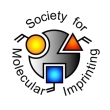
Authors: Zhao T, Wang QQ, Li J, Qiao XG, Xu ZX
Article Title: Study on an electrochromatography method based on organic-inorganic hybrid molecularly imprinted monolith for determination of trace trichlorfon in vegetables.
Publication date: 2014
Journal: Journal of the Science of Food and Agriculture
Volume: 94
Issue: (10)
Page numbers: 1974-1980.
DOI: 10.1002/jsfa.6511
Abstract: BACKGROUND Organophosphorus pesticides have been widely used in agricultural production. However, the wide use of organophosphate also results in pesticide residues on the plant, which are harmful to human health because of their potential mutagenic and carcinogenic properties. Therefore, it is vital to develop a sensitive and effective analysis method to control pesticide residues.
RESULTS In this study, a novel molecularly imprinted capillary monolithic column was prepared using trichlorfon as the template molecule by combining non-hydrolytic sol-gel process with a molecular imprinting technique. The resulting material was characterized by scanning electron microscopy and Fourier transform infrared. Under capillary electrochromatography, the effects of voltage, pH, ACN content and concentration of buffer solution on the electro-osmotic flow (EOF) of imprinted capillary monolithic column were evaluated in detail. Using this prepared material as stationary phase for capillary electrochromatography, a novel method of molecularly imprinted capillary electrochromatography (MICEC) for the detection of trace trichlorfon residues in vegetables was developed. Under optimal conditions, appreciable sensitivity was achieved with a LOD (S/N = 3) of 92.5 μg kg-1 and method quantitation limit (MQL) of 305.3 μg kg-1, respectively. The linear ranges of the calibration graph were 0.1 μg L-1 to 10 mg L-1. The peak area precision (RSD) for five replicate extractions of 0.01 mg L-1 trichlorfon standard aqueous solution was 4.5%. To evaluate the accuracy of this method, the blank cucumber and cauliflower samples spiked with trichlorfon were extracted and analyzed by this method with good recoveries, ranging from 80.2% to 95.8%. Moreover, this method was successfully applied to the quantitative detection of the trichlorfon residues in leek samples.
CONCLUSION With good properties of high sensitivity and simple pre-treatment, this MICEC method could provide a new tool for the rapid determination of trace trichlorfon residue in complex food samples. © 2013 Society of Chemical Industry
Template and target information: trichlorfon
Author keywords: Trichlorfon, molecular imprinting, capillary monolithic column, capillary electrochromatography



Join the Society for Molecular Imprinting

New items RSS feed
Sign-up for e-mail updates:
Choose between receiving an occasional newsletter or more frequent e-mail alerts.
Click here to go to the sign-up page.
Is your name elemental or peptidic? Enter your name and find out by clicking either of the buttons below!
Other products you may like:
 MIPdatabase
MIPdatabase









